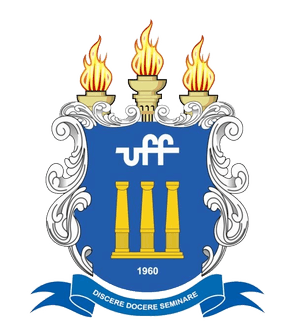Fluminense Federal University
|
Universidade Federal Fluminense | |
 Seal of Federal Fluminense University | |
Other name | UFF |
|---|---|
Former name | Universidade Federal do Estado do Rio de Janeiro (in English: Federal University of the State of Rio de Janeiro) |
| Motto | Discere, docere, seminare |
Motto in English | Learn, teach, sow |
| Type | Public |
| Established |
June 3, 1912 (Law School) December 18, 1960 (University) |
| Affiliation | CRUB,[1] RENEX,[2] REARI-RJ,[3] Utrecht Network [4] |
| Endowment | R$ 1,470 billion (2016) [5] |
| Chancellor | Sidney Luiz de Matos Mello |
| Vice-Chancellor | Antonio Claudio Lucas da Nóbrega |
| Head of Cabinet | Mário Augusto Ronconi |
Academic staff | 3,249 |
Administrative staff | 6,505 |
| Students | 66,186 |
| Undergraduates | 43,628 |
| Postgraduates | 22,168 |
Other students | 390 (Elementary, Middle and High School) |
| Location | Niterói, Rio de Janeiro, Brazil |
| Campus |
10 cities
|
| Language | Portuguese |
| Colours | White and Blue |
| Athletics | UFF Ativa [6] |
| Website |
www |
 | |
The Fluminense Federal University (Portuguese: Universidade Federal Fluminense, UFF) is a public higher education institution located mainly in Niterói and in other cities of Rio de Janeiro state. It was first established on December 18, 1960, with the name of Universidade Federal do Estado do Rio de Janeiro (UFERJ), through an integration of different academic colleges in the city of Niterói. On November 5, 1965, the current name became official.
It is considered one of the main centers of excellence in Brazil, ranked in the 9th position in the Center for World University Rankings of the best universities [7] in the country. UFF is among the top 25 universities in Latin America,[8] according to research published by the Webometrics Ranking of World Universities. Besides, UFF has become the sixteenth largest university in the country, the sixth largest public university and the third largest federal university in the country.[9]
History
UFF was established in 1960, with the name Universidade Federal do Estado do Rio de Janeiro (UFERJ). The university began with the merger of five existing federal institutions in Niterói, three state institutions and two private colleges, becoming a part of the federal government and being renamed Universidade Federal Fluminense (Federal Fluminense University).
After a rough start, with a power struggle due to the institutions’ different administrations, the military government ruling at that time imposed a model structure for the University to its units and departments. Following the country’s tradition in other institutions at the time, the main aim of the university was academic training, focusing on resources to qualify citizens for professional development. Research had a more formal role, and extension programs had different functions, with the main aim to offer services to the community. Today, these remain the three pillars of the university.
In the 1990s, UFF expanded and began to offer new programs in campuses in different towns in regional areas if Rio de Janeiro state. From these programs, new departments and colleges were established. In the 2000s, these regional units were known as University Centers (Pólos Universitários da UFF).
The University
Location (Campuses)
Its headquarters and the major amount of UFF unities are located in the city of Niterói. Besides Niterói, the university has academic unities in other cities inside the Rio de Janeiro state, being the most internalized Federal University in the country.
UFF is also part of the CEDERJ Consortium,[10] which teaches distance learning undergraduation courses through centers located in the Rio de Janeiro state.
In the city of Niterói (its headquarters)
There are three big campuses in the city: Gragoatá Campus, Praia Vermelha Campus and Valonguinho Campus, beyond other locations at the same city.
- Gragoatá Campus hosts the History, Anthropology, Social Sciences, Public Policies, Philosophy, Sociology, Psychology, Pedagogy, Letters (German, Spanish, French, Greek, English, Italian, Latin and Portuguese/Literatures), Social Service, Economics, Mathematics, Statistics, Hotel Management, Public Administration, Social Service, International Relations, Tourism and Physical Education courses. The Gragoatá Campus has contributed to a change in the neighbour its located, once strictly residential, to an area that has restaurants, bookstores and cultural areas.
- Praia Vermelha Campus hosts the all the Engineering courses of the University (Agribusiness, Chemical, Civil Engineering, Electrical, Environmental and Agricultural, Environmental and Water Resources, Mechanical, Metallurgical, Petroleum, Production and Telecommunications) and the courses of Architecture and Urbanism, Industrial Design, Public Safety, Computational Mathematics, Computational Physics, Computer Systems, Computing Sciences, Environmental Sciences, Geophysics and Physics.
- Valonguinho Campus is the closest to the ferryboat station that goes to Rio de Janeiro city and hosts the courses of Biological Sciences, Chemistry, Industrial Chemistry, Dentistry, Nutrition, Business Administration, Accounting Sciences, Management Processes, Speech Therapy and Veterinary Medicine.
Some schools and institutes are located outside campuses, such as the
- Institute of Art and Social Communication: Advertising and Propaganda, Arts, Archival Science, Cinema and Audiovisual Studies, Cultural Production, Journalism, Library Science and Documentation and Media Studies.
- Law School;
- Medical School: Medicine and Pharmacy;
- Nursing School;
- Biomedical Institute;
- Veterinary School; and
- Aurora de Afonso Costa Pharmacy School.
Along with teaching facilities, UFF is also in charge for the Antônio Pedro University Hospital, Veterinary Hospital, Geraldo Reis University School (Elementary and High School), UFF Arts Center[11] (a cultural complex with art and photographies galleries, cinema, theater, string quartet and choirs and symphonic orchestra), University Pharmacy, Accessibility and Inclusion Office, University Restaurant (low-cost meals for all the students), Shuttle bus (free campus-to-campus transportation) and Kindergarten School.
In other cities
- Campos dos Goytacazes: Economics, Social Sciences, Geography, History, Psychology and Social Service;
- Petrópolis: Production Engineering;
- Angra dos Reis: Public Policies, Geography and Pedagogy;
- Nova Friburgo: Dentistry;
- Rio das Ostras: Computing Sciences, Nursing, Production Engineering, Cultural Production, Psychology and Social Service;
- Volta Redonda: Engineering (Agribusiness, Metallurgical, Mechanical and Production), Business Administration, Public Administration, Accounting Sciences, Law, Psychology, Computational Physics, Mathematics and Chemistry;
- Santo Antônio de Pádua: Natural Sciences, Computing Sciences, Physics, Interdisciplinary Education in the Field, Mathematics and Pedagogy;
- Advanced Unity in Oriximiná, Pará;
- University Farm in Cachoeiras de Macacu;
- Quissamã: Tourism;
- Macaé: Business Administration, Accounting Sciences and Law;
- Itaperuna: Business Administration;
- Miracema: Accounting Sciences.
UFF in Numbers[12]
| Level, Students enrolled and Number of Courses | |||
|---|---|---|---|
| (A) Academic Graduate Programs | |||
| Master | Professional Master | Doctorate | Total |
| 3,601
(62 courses) |
1,218
(16 courses) |
2,620
(42 courses) |
7,439
(120 courses) |
| (B) Professional Graduate Programs | |||
| On-campus | Distance Learning | Medical Residency | Total |
| 3,021
(143 courses) |
11,517
(11 courses) |
191
(45 courses) |
14,729
(199 courses) |
| (C) Undergraduate Programs | |||
| On-campus | Distance Learning | Total | |
| 34,678
(124 courses) |
8,950
(6 courses) |
43,628
(130 courses) | |
| (D) Schools | |||
| Elementary School | Middle School | High School | Total |
| 60 | 243 | 87 | 390 |
References
- ↑ http://www.crub.org.br
- ↑ https://www.ufmg.br/proex/renex/
- ↑ https://www.facebook.com/REARI.RJ.Network
- ↑ http://www.utrecht-network.org/news/links-with-brazil/
- ↑ "Receitas e Despesas". Receitas e Despesas (in Portuguese). Universidade Federal Fluminense.
- ↑ https://www.facebook.com/UFFAtiva/
- ↑ Gasparini, Cláudia (2016-09-13). "As 18 melhores universidades brasileiras em 2014". Exame.
- ↑ "Brazil | Ranking Web of Universities". www.webometrics.info. Retrieved 2017-07-02.
- ↑ "UFF entre as melhores: 3ª maior universidade federal e 6ª maior pública do país em número de estudantes". UFF Notícias. 2011-02-23.
- ↑ "Fundação Cecierj / Consórcio CEDERJ | Educação a Distância da Universidades Públicas". Fundação Cecierj / Consórcio CEDERJ (in Portuguese). Retrieved 2017-07-02.
- ↑ "Quem somos". Centro de Artes UFF (in Portuguese). Retrieved 2017-07-02.
- ↑ "UFF em Números". Universidade Federal Fluminense (in Portuguese). Retrieved 2017-07-02.
External links
- Universidade Federal Fluminense’s website
- Center for World University Rankings
- Information about UFF Undergraduation Courses (in Spanish) (in English) (in Portuguese)
- Information about UFF Graduation Courses (in Spanish) (in English) (in Portuguese)
- Information about UFF Outreach Activities (in Spanish) (in English) (in Portuguese)
- UFF in Numbers (in English) (in Portuguese)
- UFF International Cooperation Office (in English) (in Portuguese)
- UFF Arts Center (in Spanish) (in English) (in Portuguese)
- UFF Publishing House (in Portuguese)
Coordinates: 22°54′15″S 43°07′00″W / 22.90417°S 43.11667°W